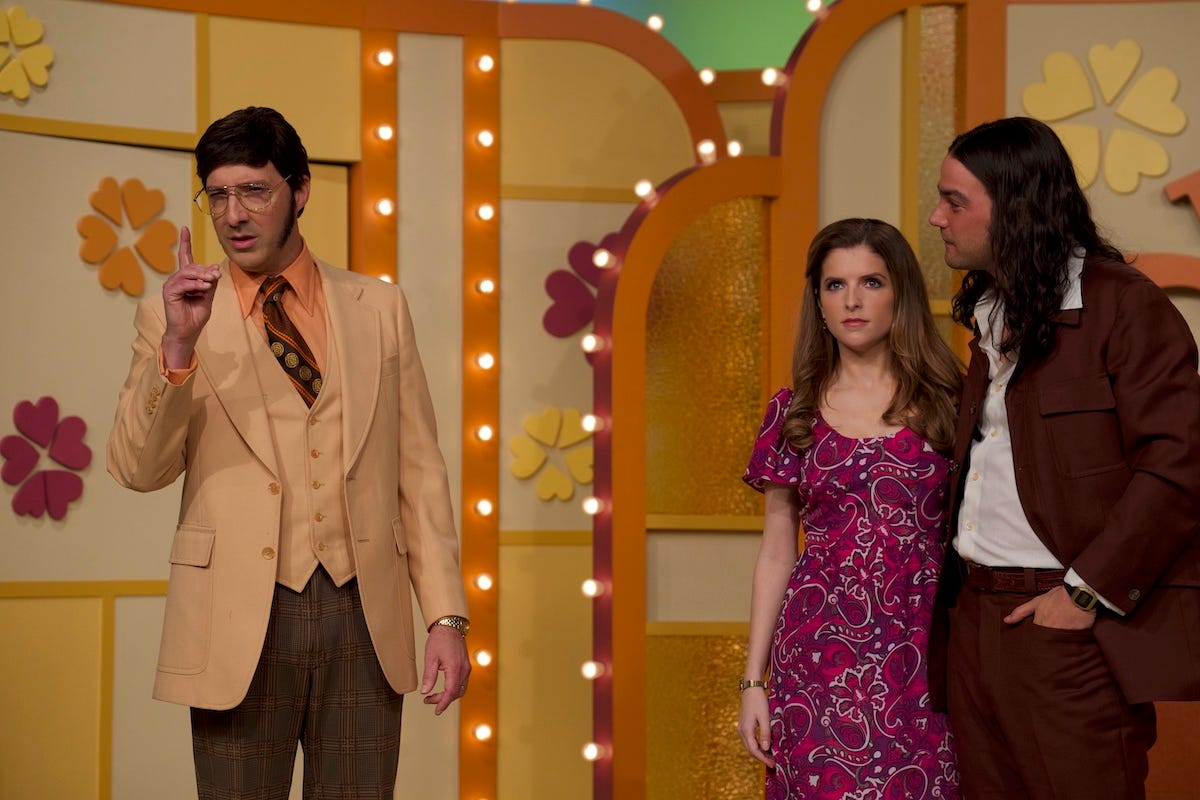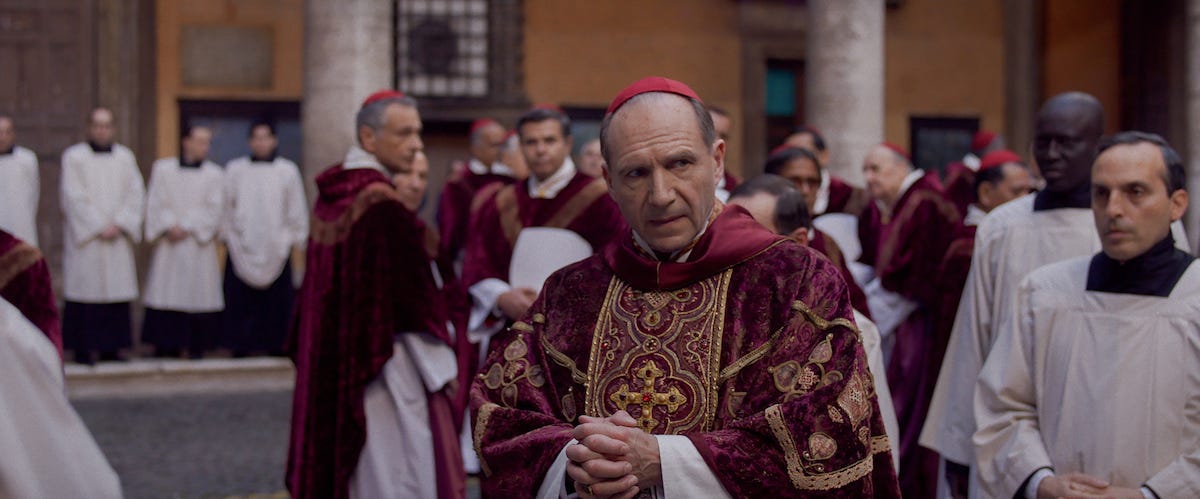There’s a really interesting sequence nearly 70 minutes into Woman of the Hour in which director Anna Kendrick demonstrates how subtly changing the position of a camera can dramatically change how we feel about a scene, and how we read the intent of the characters in that scene.
After Sheryl (Kendrick, who also stars) and Rodney (Daniel Zovatto) match on The Dating Game, they decide to grab a quick drink to get to know each other a bit better before jetting off on the vacation they won. They’re in an orange-hued tiki bar, sitting across a table from one another, and Kendrick begins the sequence in pretty standard shot-countershot: Rodney is slightly screen left, Sheryl is slightly screen right, and we cut back and forth between them as they talk. She’s a little awkward, as she has been all movie; he’s a little weird, though that’s to be expected since we’ve already seen him commit a couple of murders.1
The conversation goes on, Rodney asking why she went on The Dating Game if she doesn’t date much. And Kendrick, director, offers her own reply from the side, her face in profile. “Yeah, that’s funny. Um. My agent said it would get me seen,” she says.
And when we cut back to Rodney his face is now dead-center of the screen. He smirks. Nods.
“Did you feel seen?” he replies. Almost rhetorically.
And then Kendrick cuts back to Sheryl, who is also dead-center, and panic is starting to creep into her face, and she does that thing with her mouth that she does where it’s like she’s trying to decide whether or not to smile—as if her lips, independently of her brain, aren’t quite sure if this is really happening—and says, a little more softly, “I felt looked at.”
Rodney, still centered: “How do you feel right now?”
Sheryl, centered yet clearly off kilter, understanding that things could get very bad very quickly: “… Fine.”
The sequence continues, culminating in his chasing her through a parking lot after she tells him she would never go anywhere with him—another masterfully lit, masterfully framed, masterfully paced bit of work—but it’s this moment of conversational danger, of all Woman of the Hour’s dangerous moments, has stuck in my brain. Because that change in camera placement is the tiniest shift, the most minuscule tinkering with cinematic norms, yet one that audiences are apt to find deeply unnerving because the difference is so small, becausethe norms have been violated just so. It’s a rather perfect visual representation of the internal radar every woman has to have to keep them out of danger, to keep them from winding up a victim.
Woman of the Hour isn’t always quite this subtle. An earlier sequence—in which Laura (Nicolette Robinson) tells her boyfriend she thinks contestant Rodney is potentially a killer, to which he replies with a litany of reasons she’s probably overreacting—is as close as the movie gets to screaming its main thematic point (BELIEVE WOMEN, a subtitle might as well be flashing). But even in this moment, there’s a worse version of this film that concludes that sequence with a big speech about how women are in danger because men never find themselves in the same sort of danger, because they aren’t surrounded by one half of the population that’s physically stronger and more chemically inclined toward violent impulses.
Speeches aren’t necessarily the enemy of art, but they are sometimes the enemy of good art.
Conclave doesn’t quite close with a speech, but a speech certainly sets the stage for the close in the most hamfisted way possible.
Some spoilers of Conclave are coming up—including an acknowledgment of which cardinal is chosen to be the next pope in the film—so if you’re worried about that sort of thing, please stop reading now!
Edward Berger’s movie was always headed toward this speech; it was inevitable, obvious from the early going. No one would ever mistake Conclave for a subtle movie; I saw someone derogatorily refer to it as Sorkinesque in its sensibilities, and rarely has that adjective been more apt. Cardinals have gathered at the Vatican in order to select a new pope following the passing of the previous; there is sadness, of course, but also a hum of excitement as the gathered realize that one of them will be walking away as pontiff.
Lawrence (Ralph Fiennes) is in charge of the proceedings as dean of the College of Cardinals. The pope under whom he served was a liberal, reform-minded pope, and he and his liberal, reform-minded allies hope to appoint Bellini (Stanley Tucci) his successor; you know he’s Good, since he tells his allies he thinks women should have a role to play in the priesthood. Their main opponent is Tedesco (Sergio Castellitto), an ultra-conservative Italian Catholic; you know he’s Bad, because he thinks that the Catholic Church needs to get rid of all this, ugh, diversity.
Speaking of which, there’s Adeyemi (Lucian Msamati), an African cardinal who is an economic liberal and social conservative; sure, he might want to imprison gays, but at least he’d be the first black pope! (Note: This is an actual argument one of the liberal cardinals makes, and with a straight face.) Cardinal Tremblay (John Lithgow), meanwhile, is conservative, but not too conservative. He’s also an operator, an expert politician, skilled in the subtle art of papal knife-fighting. He sees ten moves ahead of everyone, though whispers are circulating that the pope had asked him to resign before dying.
And then there’s Cardinal Benitez (Carlos Diehz). No one knows who this cardinal is when he shows up at the conclave. Turns out he’s the cardinal of Kabul, ordained in secret due to the grave threat he would suffer if exposed. Needless to say, it’s Cardinal Benitez—who has washed the feet of those suffering in war zones; who is untainted by the ugliness of the Vatican’s squabbles—that is most Christlike amongst all these men of God. It doesn’t take a script doctor to see where this movie is headed within moments of his appearance, but that doesn’t mean writer Peter Straughan had to seal the deal by giving Benitez the sort of speech that, if this were a parody film, would result in a slow-clap from the College of Cardinals signifying his election as the supreme pontiff.
There’s a final revelation that ties all the film’s themes together in a nice little bow—I won’t spoil it here; suffice to say that after it played out onscreen, all the Oscar buzz around this well-acted but slight procedural made a lot more sense—and that’s fitting, since this is one of those movies that needs to signify everything on a screenplay level. Conclave’s characters are constantly telling us how we should feel about them with their casual bigotries and their increasing arrogance. This isn’t to say the movie looks bad. Shots are well framed, and the lighting creates just enough mood and shadow for us to feel as if we’re ensconced in a mystery.
But considering the size and scope and cast—and the fact that Berger earned a bushel of Oscar nominations for his previous effort, his wearily unsubtle adaptation of All Quiet on the Western Front—it’s at least a little surprising that first-time director Anna Kendrick ran visual rings around him on a storytelling level.
The film is about a real-life incident in which a serial killer went on The Dating Game and won, and one of the smart structural things this movie does is that it doesn’t try to hide he’s a killer. We know he’s a killer; that’s why we’re watching the movie. There’s nothing worse than a movie that reveals its premise 40 seconds into its trailer and still waits 40 minutes to unveil in the film itself. (Abigail, I’m looking at you.)







"Woman of the Hour" sounds interesting based on your description of the camera work here. The main thing I noticed rewatching "Silence of the Lambs" recently for the first time in decades was how much the movie uses unusual framing (specifically, close shots of people looking right at the camera) to make you feel Clarice Starling's discomfort on a truly visceral level.
I went to Conclave, only the 2nd or 3rd movie in the theater this year; Sorry Sonny, I'll do better.
I knew all the spoilers, and let me just say, I'm not ready to do your job, but I thought the film did an excellent job of transmitting the weight of the decisions the men faced. I really felt the pressure on Cardinal Lawrence. I felt the striving and excitement of the men who could become pope. And since I'm never going to be in any of those roles, I thought the film was well done. The spin at the end was ... a bit gratituous.